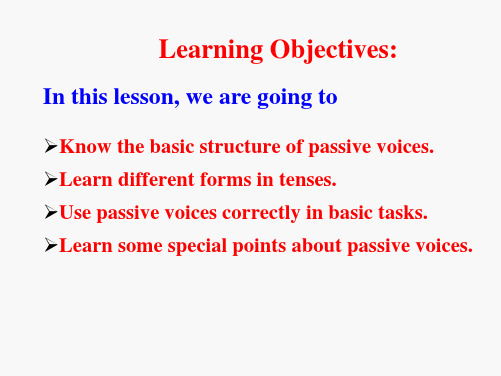被动语态英语公开课课件
合集下载
被动语态公开课ppt课件.ppt

3. We have put off the basketball match. The basketball match has been put off.
4. We will finish our class next week.
Our class will be finished next week.
was/were 一般过去时
was/were+being 过去进行时
had+been 过去完成时
would+be 过去将来时 情态动词+be 情态动词
will have been 将来完成时
be + 被动的一般公式 • do------ __b__e_d_o_n_e____ • have done------------_h_a_v_e_b_e_e_n__d_o_n_e__ • had done-------------h__a_d_b_e_e_n__d_o_n_e___
•3. No animals are allowed (allow) in the stadium.
•4. Cheating by athletes are not excused (not excuse). They are told (tell) to leave and punished (punish).
Rules for the Olympic Games
•1. Nobody is allowed (allow) to enter the stadium without a ticket.
• 2. Children are not allowed (not allow) to make a noise and upset the competitors. If they do, they will be taken away (take away) from the stadium.
4. We will finish our class next week.
Our class will be finished next week.
was/were 一般过去时
was/were+being 过去进行时
had+been 过去完成时
would+be 过去将来时 情态动词+be 情态动词
will have been 将来完成时
be + 被动的一般公式 • do------ __b__e_d_o_n_e____ • have done------------_h_a_v_e_b_e_e_n__d_o_n_e__ • had done-------------h__a_d_b_e_e_n__d_o_n_e___
•3. No animals are allowed (allow) in the stadium.
•4. Cheating by athletes are not excused (not excuse). They are told (tell) to leave and punished (punish).
Rules for the Olympic Games
•1. Nobody is allowed (allow) to enter the stadium without a ticket.
• 2. Children are not allowed (not allow) to make a noise and upset the competitors. If they do, they will be taken away (take away) from the stadium.
被动语态公开课课件

过去被动语态
was/were + 过去分词(例如:The movie was directed by the famous director.)
02
被动语态的用法
用于强调动作的承受者
总结词
在某些语境中,我们使用被动语态来强调动作的承受者,而不是动作的执行者。
详细描述
被动语态可以使句子更加聚焦于动作的承受者,突出其重要性和关注点。例如, “The book was written by the author”这句话中,重点是书本身,而不是写 书的作者。
03
被动语态的构成
现在时被动语态
现在时被动语态的构 成:be + 过去分词
现在时被动语态的时 态变化:根据主语的 人称和数进行变化
现在时被动语态的用 法:表示当前正在进 行的动作或存在的状 态
过去时被动语态
过去时被动语态的构成: was/were + 过去分词
过去时被动语态的用法:表示 过去某个时间发生的动作或存 在的状态
选择题2
The book _____ by me in 2018.
选择题3
The book _____ in 2018.
选择题4
The book _____ by me.
改错题练习
改错题1
The book has been written by me. (改为被动语态)
改错题2
The book was written by me. (改为被动语态)
翻译练习4
这本书已经被印刷了三次。 (被动语 态)
THANKS
感谢观看
详细描述
在英语中,当我们要表达某件事情是可以被完成时,也可以使用被动语态。例如,“The work can be done by him.”这句话表示这项工作可以由他来完成。
被动语态公开课PPT课件

名词的变化
动词变名词
形容词变名词
名词加-y变名词
动词加-er变名词
代词的变化
变化规则:根据句子主语的 变化而变化
代词:被动语态中的主语代 词变化
代词的变化形式:根据不同 的时态和语态而变化
代词的变化意义:表示动作 的执行者或接受者
冠词的变化
用于单数名词前,表示类别
用于复数名词前,表示多数
用于不可数名词前,表示数量
科技文献中的应用
描述科学实验结果
撰写科技论文
编写专利申请书
描述工程设计中的细节
商业文书中的应用
商业计划书 年度报告 合同协议 产品说明书
日常生活中的运用
新闻报道:新闻报道中经常使用被动语态来客观地描述事件 科技文献:科技文献中被动语态的运用可以让读者更加专注于研究本身 商业报告:商业报告中被动语态的运用可以让报告更加客观、可信 法律文书:法律文书中被动语态的运用可以让法律条文更加清晰、简洁
been done
被动语态完成 进行时: have/has
been being done
被动语态的句型应用
基本句型结构
被动语态的时态
添加标题
添加标题
特殊句型结构
添加标题
添加标题
被动语态的否定和疑问句型
PART 4
被动语态的词汇变化
动词的变化
过去分词形式变 化
助动词be的变化
动词的时态变化
动词的语态变化
YOU,a click to unlimited possibilities
汇报人:
时间:20XX-XX-XX
目录
01
02
03
04
05
06
被动语态公开课课件

谓语不同
2
主动语态使用“be+过去分词”结构,而被动语态使用“助
动词be+及物动词的过去分词”结构。
强调重点不同
主动语态强调动作执行者,而被动语态强调动作本身和接受 者。
联系
01
语态可以转换为被动 语态,反之亦然。
使用场合
在某些语境中,主动语态 和被动语态都可以使用, 但选择使用哪一种取决于 说话者的意图和语境。
新闻报道
新闻报道中被动语态的使 用可以突出事件本身,强 调事件的重要性和影响力 ,同时避免主观色彩。
法律文书
在法律文书中,被动语态 常被用来表述法律条文、 合同条款等,确保表述的 严谨性和公正性。
练习
替换练习
给出主动句,要求学生将其转换 为被动句,锻炼学生对被动语态
的运用能力。
段落改写
提供一段含有主动语态的段落, 要求学生将其全部转换为被动语 态,提高学生对整体语境的把握
被动语态的进行时形式是“主语 +be+being+过去分词+by引导的方 式状语”,如“The book is being written by John”。
03
被动语态的用法与注意事项
用法
定义
被动语态是英语中一种重要的语法结 构,表示主语是动作的接受者而非执 行者。
时态变化
被动语态还有一些特殊用法,如情态 动词的被动语态、被动语态与系动词 be的省略等。
能力。
情境模拟
设置实际情境,要求学生运用被 动语态进行表达,培养学生在实 际交流中运用被动语态的能力。
THANKS
构成
被动语态由助动词be( am/is/are/was/were)+过去分词 构成。
被动语态ppt课件完整版

一般现在时、过去时、将来时
一般现在时被动语态
am/is/are + 动词过去分词,表示经 常性或习惯性的动作,或与现在事实 相联系的情况。
一般将来时被动语态
will be + 动词过去分词,表示将来某 一时间要发生的动作或存在的状态。
一般过去时被动语态
was/were + 动词过去分词,表示过 去某一时间发生的动作或存在的状态 。
议上讨论。)
动词形式变化规则
现在进行时
am/is/are being+过去分词。例如:The house is being repaired. (房子正在修理中。)
过去进行时
was/were being+过去分词。例如:He was being operated on when we arrived.(我们到达时他正在接受手术。)
情态动词后接完成式时,有时也可以表示虚拟语气,表示与 过去事实相反的假设或愿望。在这种情况下,句子通常使用 倒装语序,即把情态动词放在主语之前。
05Байду номын сангаас
误用与避免方法探讨
常见误用类型分析
主谓不一致
在被动语态中,主语通常是动作的承受者,谓语应与主语保持一致。然而,有时会出现主 谓不一致的错误,如“The book was wrote by him.”(正确形式应为“The book was written by him.”)
如果不定式前面的名词是对句子的主语的特点进行的说明的时候,使用不定式的主 动语态表示被动含义。
在there be句型中,当动词不定式修饰名词作定语时,不定式用主动式作定语,重 点在人。
动名词作主语或宾语补足语时
动名词作主语时,谓语动词为单数,在动名词和不定式中,作为介词的宾语是动 名词,动名词的否定直接在其前加否定词,通过代词的宾格或所有格形式给出逻 辑主语。
公开课《被动语态》ppt课件

03
was/were done,表示过去某个时间发生的被动动作。
将来时与被动语态结合
将来进行时的被动语态
will be being done,表示“将来某个时间正在被做”的动作。
将来完成时的被动语态
will have been done,表示“将来某个时间之前已经被做”的动 作。
一般将来时的被动语态
will be done,表示将来某个时间要发生的被动动作。
完成时与被动语态结合
现在完成进行时的被动语态
have/has been being done,表示“从过去一直持续到现在并 且还在被做”的动作。
过去完成进行时的被动语态
had been being done,表示“过去的过去一直持续到过去某个 时间并且还在被做”的动作。
疑问句中使用被动语态
疑问句中使用被动语态时,需要将be 动词提前至主语之前,形成疑问语序 。
疑问句中使用被动语态的结构为:Be 动词 + 主语 + 过去分词 + (by + 动 作执行者)?
疑问句中的被动语态同样用来强调动 作的执行者或不需要指出动作的执行 者。
感叹句中使用被动语态
感叹句中使用被动语态时,通常用来 表达对某个动作或状态的强烈感受。
与主动语态对比
01
主动语态
主语是动作的执行者,强调动作的执行者。
02
被动语态
主语是动作的承受者,强调动作的承受者或使宾语变为被动语态的主语,将主动语态的 谓语动词变为被动语态的“be+过去分词”形式。
常见误区及解析
A
误区一
认为所有动词都可以用于被动语态。实际上, 只有及物动词和部分相当于及物动词的动词短 语才能用于被动语态。
被动语态讲解公开课PPT课件

初中被动语态的奥秘
中考必考的重点语法
第1页/共41页
语态
语态:表示主语和谓语动词之间的关系。 英语有两种语态,即主动语态和被动语态。
主动语态:表示主语是动作的执行者。被动语态:表示主语是动作的承受者。 如: Many students study English.(主动语态) English is studied by many students.
• Children will take some photos in the schoolyard tomorrow.
Some photos will be taken by children in the school tomorrow.
• The headmaster will give a talk this afternoon.
was given by
第24页/共41页
3. A lot of people in China can speak English now . (同上) English ______ ____ ______ by a lot of people in China now.
4. I have learned English for about two years. (同上) English ______ ___c_a_n_ _b_e____spfoorkaebnout two years.
The teacher often asks him questions.
He
is asked
questions
by the teacher.
1.把主动语态的宾语变为被动语态的主语。
2.把主动语态的谓语变为被动语态的谓语。 3.把主动语态的主语变为被动语态的by
中考必考的重点语法
第1页/共41页
语态
语态:表示主语和谓语动词之间的关系。 英语有两种语态,即主动语态和被动语态。
主动语态:表示主语是动作的执行者。被动语态:表示主语是动作的承受者。 如: Many students study English.(主动语态) English is studied by many students.
• Children will take some photos in the schoolyard tomorrow.
Some photos will be taken by children in the school tomorrow.
• The headmaster will give a talk this afternoon.
was given by
第24页/共41页
3. A lot of people in China can speak English now . (同上) English ______ ____ ______ by a lot of people in China now.
4. I have learned English for about two years. (同上) English ______ ___c_a_n_ _b_e____spfoorkaebnout two years.
The teacher often asks him questions.
He
is asked
questions
by the teacher.
1.把主动语态的宾语变为被动语态的主语。
2.把主动语态的谓语变为被动语态的谓语。 3.把主动语态的主语变为被动语态的by
高中英语被动语态课件(共16张PPT)

2. 由动词+ 介词或副词构成的短语动词,要把它们作为整体看,即 把它们看成一个及物动词,介词或副词不可拆开或漏掉。这类动词 有: (1)不及物动词+ 介词,如: agree to, ask for, laugh at, operated on, listen to, look after, think of, talk about 等。 The patient is being operated on. The problem is solved. It needn't be talked about. (2)及物动词+ 副词:如:bring about, carry out, find out, give up, hand in, make out, pass on, point out, put away, put off, think over, turn down, work out, turn out 等。 His request was turned down. The sports meet will be put off because of the bad weather.
被动: The price has been brought down.
7. 过去完成时: had + been + given
1) 主动:When I got to the theatre, I found they had already sold out the tickets.
被动:When I got to the theatre, I found the tickets had already been sold out.
动词的过去分词”构成。 1)主动:You must hand in your compositions after
被动语态课件(20张ppt)

结构上的错误
总结词
结构上的错误是指句子中的结构不完整或结 构混乱,导致句子意义不清或语法错误。
详细描述
结构上的错误通常是由于句子中的结构不完 整或结构混乱所导致的。例如,“The book was written by him and published in 2019”这句话中,“and”连接了两个 并列的谓语动词“written”和 “published”,但是“and”前没有主语, 因此这个句子存在结构上的错误。
例如,在句子"The book was written by him."中,"was written"是被动语 态的形式,表示"书"是动作"写"的接 受者。
被动语态的分类
根据时态和语态的不同,被动语态可 以分为多种形式。
此外,还有被动语态的虚拟语气形式 等。
例如,现在进行时的被动语态形式为 "am/is/are being done",过去完成 时的被动语态形式为"had been done"。
04
被动语态的注意事项
使用被动语态的场合
强调动作的承受者
01
当需要强调动作的承受者而不是动作的执行者时,可以使用被
动语态。
不知道或不需要指出动作执行者
02
在某些情况下,可能不知道或不需要指出动作的执行者,此时
使用被动语态可以避免提及。
强调客观事实或信息的传递
03
在描述客观事实或传递信息时,使用被动语态可以使句子更加
被动语态课件
• 被动语态的定义 • 被动语态的用法 • 被动语态的练习 • 被动语态的注意事项 • 被动语态的常见错误分析
被动语态公开课PPT课件ppt

例子:I am seen, They are watched
表示动作已经完成,强调主语是动作的承受者
常用于描述现在或过去的某个时间点发生的动作或状态
过去时被动语态
定义:表示过去某个时间发生的动作或状态
用法:用于描述已经发生的事情,如历史、新闻报道等
与现在时被动语态的区别:过去时被动语态使用过去分词,而现在时被动语态使用现在分词
完成以下练习题并核对答案
练习题二
用被动语态改写主动语态句子
根据提示信息写出被动语态句子
将给出的动词改写成被动语态
翻译英文被动语态句子
练习题三
翻译下列句子,并用被动语态表达
选词填空,并用被动语态表达
用被动语态改写下列句子
完成下列短文,并将其改为被动语态
答案与解析
练习3答案:A
练习1答案:B
练习2答案:C
定义:被动语态是一种动词形式,表示主语是动作的接受者
用法:通常用于描述主语遭受、经历、发生的事情或动作
被动语态的特殊用法
被动语态与系表结构的区别
带有复合宾语的被动语态
带有两个宾语的被动语态
带有情态动词的被动语态
被动语态与系表结构的区别
添加标题
添加标题
添加标题
添加标题
结构不同:被动语态的结构是“be+动词的过去分词”;系表结构中系动词和表语都是单词。
构成:be动词的过去式+动词的过去分词
将来时被动语态
定义:表示将来的动作或状态
构成:will be + 动词的过去分词
用法:常用于描述未来的计划、安排或预测
示例:The building will be completed next year.
被动语态全ppt课件

时态不一致错误
错误示例
The letter was wrote yesterday.
纠正方法
将was wrote改为was written,即The letter was written yesterday.
注意事项
在被动语态中,谓语动词的时态要与句子中的时间状语保 持一致。如果时间状语是过去时,谓语动词要用过去时的 被动语态形式。
作用
被动语态在句子中主要起强调动 作承受者、使句子结构平衡、表 达客观事实等作用。
构成要素
助动词be+动词的过去分词
被动语态的基本构成是助动词be加上动词的过去分词。根据时态和主语的不同 ,助动词be会有不同的形式。
by+动作执行者
在被动语态中,动作的执行者通常由介词by引出,放在谓语动词之后。如果动 作执行者不明确或不重要,可以省略。
选择题
• 题目2:The house _____ we live in is very old.
选择题
A. which B. that
C. in which
选择题
答案:C
解析:此句为定语从句,先行词为house,在从句中作live in的宾语,因此应用关系代词which或that,且live in为不及物动 词短语,需加上介词in。因此正确答案为C。
填空题
题目1
The film _____ (direct) by a famous director.
答案
was directed
解析
根据句意可知,此句应用一般过去时,且film与direct之 间为被动关系,因此应用一般过去时的被动语态was directed。
题目2
The book _____ (translate) into many languages since it was published.
- 1、下载文档前请自行甄别文档内容的完整性,平台不提供额外的编辑、内容补充、找答案等附加服务。
- 2、"仅部分预览"的文档,不可在线预览部分如存在完整性等问题,可反馈申请退款(可完整预览的文档不适用该条件!)。
- 3、如文档侵犯您的权益,请联系客服反馈,我们会尽快为您处理(人工客服工作时间:9:00-18:30)。
¡
Exercise 1. Windows_____ C of glass. A. be made B. is made C. are made D. been made 2. The house_____ in 2004. C A. is built B. is building C. was built D. used 3. A coat can_____ A for keeping warm. A. be used B. is used C. been used D. used
语法精讲——被动语态
被动语态的用法
1. 不知道或没有必要指出动作的执行者 是谁。 This watch is made in China.
Many trees should be planted every year.
2. 需要强调或突出动作的承受者。 Chinese is spoken by more and more people in the world. 被动语态的基本构成:
He told me that he would hold a party
this evening.
He told me that a party would be
held by him this evening.
8.过去完成时 had +been done
Before he told me ,I had finished all the work.
各种时态的被动语态形式 一般现在时: am/is/are +done 一般过去时:was/were +done 一般将来时:shall/will + be done 现在进行时: be +being done 过去进行时: was/were +being done 现在完成时: has /have +been done 过去完成时:had +been done 过去将来时:would/should + be done
They will plant trees tomorrow.
Trees will be planted by them
ቤተ መጻሕፍቲ ባይዱ
3.一般将来时 shall/will /be going to+ be done
tomorrow He is going to write a letter to his mother. A letter is going to be written to his mother by him.
All the work had been finished by me ,before he told me.
情态动词被动语态 动词 +be done
The work must be done at once. Many trees should be planted to protect the Waste paper can't be thrown here.
1.一般现在时 am/is/are +done
We clean the classroom every day. The classroom is cleaned by us
every day.
2.一般过去时
was/were+done
He put on a coat. A coat was put on by him.
by me now.
6.过去进行时 was/were +being done
We were watching TV at eight
yesterday. TV was being watched by us at eight yesterday.
5.过去将来时
would/should + be done
4.现在完成时 has /have +been done
Jim has finished the work.
The work has been finished by Jim.
5.现在进行时
be +being done
I am doing my homework now.
My homework is being done
4. Watches____ A Shanghai last long. A. are made in B. is made C. are made from D. made 5. This desk is made _____ A wood. A. of B. from C. in D. by 6. The things on show were ____ D the old days. A. used B. used to C. used for D. used in 7. Silk _____ A in Suzhou and Hangzhou. A. is produced B. are produced C. produced D. is produces
Exercise 1. Windows_____ C of glass. A. be made B. is made C. are made D. been made 2. The house_____ in 2004. C A. is built B. is building C. was built D. used 3. A coat can_____ A for keeping warm. A. be used B. is used C. been used D. used
语法精讲——被动语态
被动语态的用法
1. 不知道或没有必要指出动作的执行者 是谁。 This watch is made in China.
Many trees should be planted every year.
2. 需要强调或突出动作的承受者。 Chinese is spoken by more and more people in the world. 被动语态的基本构成:
He told me that he would hold a party
this evening.
He told me that a party would be
held by him this evening.
8.过去完成时 had +been done
Before he told me ,I had finished all the work.
各种时态的被动语态形式 一般现在时: am/is/are +done 一般过去时:was/were +done 一般将来时:shall/will + be done 现在进行时: be +being done 过去进行时: was/were +being done 现在完成时: has /have +been done 过去完成时:had +been done 过去将来时:would/should + be done
They will plant trees tomorrow.
Trees will be planted by them
ቤተ መጻሕፍቲ ባይዱ
3.一般将来时 shall/will /be going to+ be done
tomorrow He is going to write a letter to his mother. A letter is going to be written to his mother by him.
All the work had been finished by me ,before he told me.
情态动词被动语态 动词 +be done
The work must be done at once. Many trees should be planted to protect the Waste paper can't be thrown here.
1.一般现在时 am/is/are +done
We clean the classroom every day. The classroom is cleaned by us
every day.
2.一般过去时
was/were+done
He put on a coat. A coat was put on by him.
by me now.
6.过去进行时 was/were +being done
We were watching TV at eight
yesterday. TV was being watched by us at eight yesterday.
5.过去将来时
would/should + be done
4.现在完成时 has /have +been done
Jim has finished the work.
The work has been finished by Jim.
5.现在进行时
be +being done
I am doing my homework now.
My homework is being done
4. Watches____ A Shanghai last long. A. are made in B. is made C. are made from D. made 5. This desk is made _____ A wood. A. of B. from C. in D. by 6. The things on show were ____ D the old days. A. used B. used to C. used for D. used in 7. Silk _____ A in Suzhou and Hangzhou. A. is produced B. are produced C. produced D. is produces
